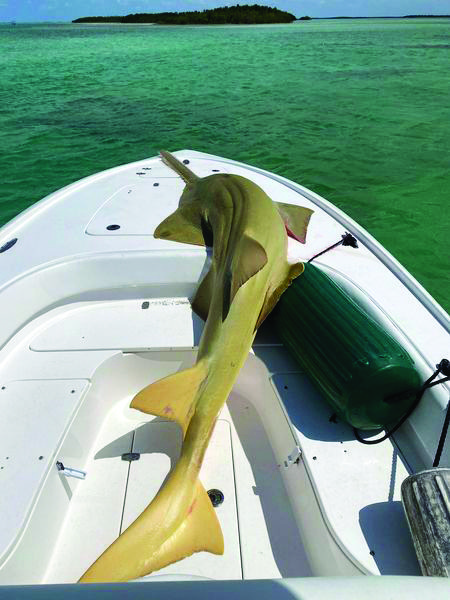by Tonya Wiley, Havenworth Coastal Conservation
Investigating death – what we can learn from recent sawfish mortalities.

The purpose of necropsies is to collect samples for gaining insight into the biology of the species and to attempt to determine the cause of death. Necropsies of sawfish which have died in the wild provide the opportunity to collect data necessary for understanding age, growth, maturity, and reproduction. In the case of other, non-endangered species this type of biological data is typically gathered by sacrificing some individuals within the population. But sacrificing any endangered sawfish is not an option given their reduced population size, so carcass recoveries provide scientists with these valuable opportunities.

Florida Fish and Wildlife Conservation Commission (FWC) sawfish biologists recently responded to collect several large smalltooth sawfish which had died in the Florida Keys. Curiously all were large females; one a mature 16-foot female, https://www.facebook.com/FWCResearch/photos/a.611845082164895/4713223488693680 and another an immature female measuring 12 feet, 4 inches long https://www.facebook.com/floridakeyssheriff/posts/10157727440136816. The 16-foot sawfish was particularly interesting as it was the longest measured by scientists in the United States since research began on the species. There were no obvious causes of death for any of the sawfish recovered from the Keys this spring (whether natural or environmental); however, a number of samples were collected from each. At the very least though, valuable life history information will continue be collected from each carcass due to the swift response from Keys-based FWC Fish and Wildlife Research Institute staff and Monroe County Sheriff’s Office personnel to secure the carcasses for study.

Sawfish biologists are working to learn as much as possible from all samples they collect from necropsies. The vertebrae will be used to determine the age of each sawfish. Reproductive tissues will be used to assess the reproductive status (mature or immature) of each dead sawfish. and used in combination with age and length to fine tune both age and length at maturity for females in the wild population. DNA collected from tissue samples will be sequenced to compare to other sawfish throughout Florida, which is useful in understanding population structure, diversity within the population, and both the size and health of the current population in comparison to the historical one. Stable isotopic analyses can be run on tissue samples and compared to a variety of potential prey items in the environment to determine the diet and trophic position of smalltooth sawfish within the food web. Blood samples are collected from sawfish to investigate reproductive status as hormones within the blood can be used to assess reproductive maturity and timing. Samples are preserved for further analysis in the future which may provide insight into environmental conditions at their time of death. Collection of the sawfish and necropsy activities were conducted pursuant to NMFS ESA Permit No. 21043.
If you catch or see a sawfish (living or dead), take a quick photograph of the sawfish, estimate its size, note your location, and please share the details with scientists. The details of your sightings or catches of sawfish help scientists collect valuable information to help monitor the population and track the recovery progress. You can share your information by visiting www.SawfishRecovery.org, calling 1-844-4SAWFISH, emailing sawfish@myfwc.com, or submitting the information through the FWC Reporter app.
Tonya Wiley, President
Tonya@havenworth.org
941-201-2685
Tax-deductible donations to help us continue our mission to promote the sustainable use and conservation of marine resources through research, outreach, and education can be made at https://havenworth.wedid.it/
